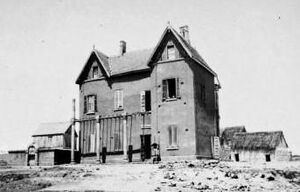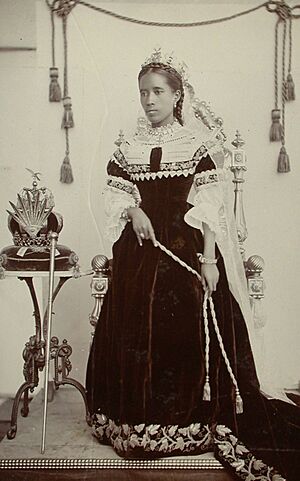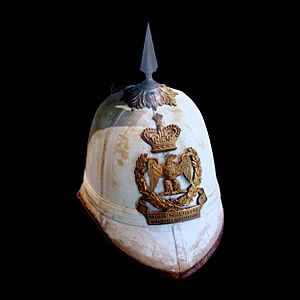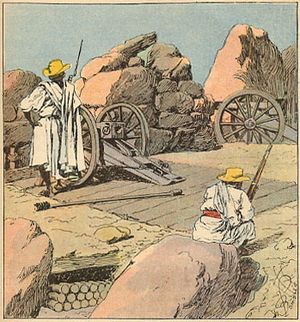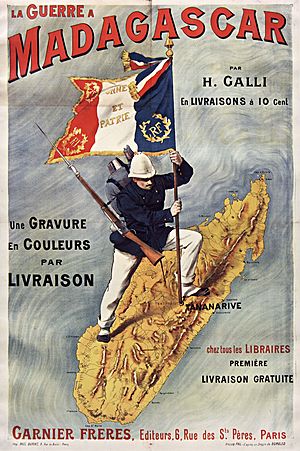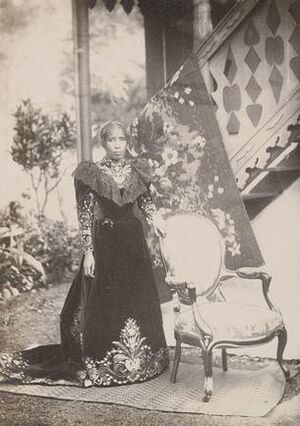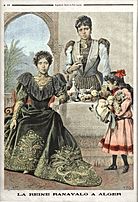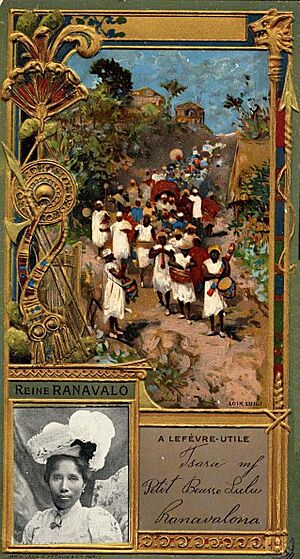Ranavalona III facts for kids
Quick facts for kids Ranavalona III |
|||||
|---|---|---|---|---|---|
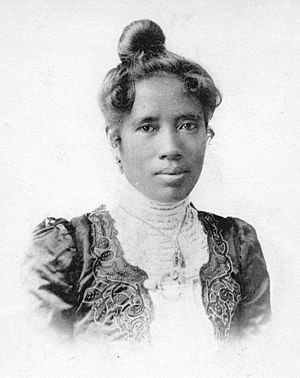 |
|||||
| Queen of Madagascar | |||||
| Reign | 30 July 1883 – 28 February 1897 | ||||
| Coronation | 22 November 1883 | ||||
| Predecessor | Ranavalona II | ||||
| Successor | Monarchy abolished Marie-Louise (as head of the Hova dynasty) |
||||
| Prime Ministers | Rainilaiarivony Rainitsimbazafy Rasanjy |
||||
| Born | Razafindrahety 22 November 1861 Amparibe, Manjakazafy, Madagascar |
||||
| Died | 23 May 1917 (aged 55) Algiers, French Algeria |
||||
| Burial | 1917 (original) 1938; 2007 (reinterred) Saint-Eugene cemetery of Algiers (original) Rova of Antananarivo Ambohimanga (reinterred) |
||||
| Spouse |
|
||||
|
|||||
| Dynasty | Hova | ||||
| Father | Andriantsimianatra | ||||
| Mother | Princess Raketaka | ||||
| Religion | Protestantism | ||||
| Signature |  |
||||
Ranavalona III (born 22 November 1861, died 23 May 1917) was the last queen of the Kingdom of Madagascar. She ruled from 1883 to 1897. During her reign, she tried to stop France from taking over her country.
When she was young, she was chosen to become queen after Ranavalona II died. Like the queens before her, Ranavalona married Rainilaiarivony, who was the Prime Minister. He was in charge of the kingdom's daily business and foreign affairs. Ranavalona tried to keep Madagascar independent by making friends and trading with other countries. However, France attacked coastal towns and the capital city, Antananarivo. The royal palace was captured in 1895, which ended Madagascar's independence.
At first, Ranavalona and her court were allowed to stay, but they had no real power. A rebellion against the French, called the menalamba rebellion, started. Also, some people at court were planning against the French. Because of this, the French sent Ranavalona away to the island of Réunion in 1897. Rainilaiarivony died that same year. Ranavalona was then moved to a house in Algiers, with some of her family. The queen and her family were given money and lived comfortably. They even took trips to Paris for shopping and sightseeing. However, Ranavalona was never allowed to go back to Madagascar, even though she asked many times. She died in Algiers in 1917 when she was 55. Her body was first buried in Algiers. Later, it was moved back to Madagascar and buried in the tomb of Queen Rasoherina.
Contents
Early Life of Princess Razafindrahety
Ranavalona III was born Princess Razafindrahety on 22 November 1861. Her parents were Andriantsimianatra and Princess Raketaka. She was born in Amparibe, a village near Antananarivo. Razafindrahety was the niece of Queen Ranavalona II. She was also the great-granddaughter of King Andrianampoinimerina. This meant she could become queen of the Kingdom of Madagascar.
When she was old enough, her aunt, Queen Ranavalona II, took care of her. The queen made sure Razafindrahety got a private education. Her teacher was from the London Missionary Society (LMS). She was a hardworking and curious child. She loved studying the Bible, learning, and reading. She got along well with her teachers.
She continued her education at different schools. These included the Congregational School of Ambatonakanga and the LMS Girls' Central School. She became a Protestant at Ambohimanga in 1874. Her teachers always said she was one of their best students.
As a young woman, Razafindrahety married a nobleman named Ratrimo. He died a few years later in 1883. This made Razafindrahety a widow at a young age. The Prime Minister, Rainilaiarivony, had a lot of power. He often chose who would be the next queen. This queen would then marry him. This was part of a system where power was shared between the monarch and the prime minister.
Ranavalona III became queen after Queen Ranavalona II died on 13 July 1883. She moved into a royal house in Antananarivo. Her coronation ceremony was held on 22 November 1883. This was her 22nd birthday. She was given the title "Her Majesty Ranavalona III by the grace of God and the will of the people, Queen of Madagascar."
She changed a tradition at her coronation. She had 500 boys and 400 girls from the best schools join the ceremony. The girls wore white, and the boys wore soldier uniforms. They performed military drills with spears. Ranavalona wore a white silk dress with gold decorations. People described her as a bit taller than average. She had delicate features and seemed shy.
Like the queens before her, Ranavalona married Prime Minister Rainilaiarivony. The young queen's job was mostly ceremonial. This meant she attended events but did not make big decisions. The much older and more experienced prime minister made almost all important political choices. Ranavalona often gave speeches to the public for Rainilaiarivony. She also opened new public buildings, like a hospital and a girls' school.
Her aunt, Ramisindrazana, was an important adviser to the queen. Ranavalona's older sister, Rasendranoro, also lived with her. An American journalist said Ranavalona liked flying kites and playing games with her family. She also enjoyed knitting and needlework. She often brought her craft projects to meetings. She loved fancy clothes and bought most of them from Paris. She invited a French magician, Marius Cazeneuve, to perform at her court. He also worked for French intelligence, trying to increase French influence.
The Franco-Hova War
As queen, Ranavalona III was caught in a long struggle between Britain and France. Both countries wanted more power in the region. Tensions between France and Madagascar grew stronger before Ranavalona became queen. In 1883, France attacked Madagascar's coast. They took over Mahajanga and Toamasina.
To protect Madagascar, Prime Minister Rainilaiarivony hired Digby Willoughby. He was a Briton who had experience in wars. His job was to train the queen's army to defend the island from a French invasion.
Madagascar tried to negotiate with France, but they could not agree. In 1885, France sent an ultimatum to Antananarivo. They demanded control over parts of Madagascar and a large payment. Ranavalona and Rainilaiarivony signed a peace treaty in 1886. They believed an explanation attached to the treaty protected Madagascar's independence. However, France published the treaty without this explanation. They then declared Madagascar a French protectorate, meaning France would control it.
Other countries reacted differently. Britain did not want to upset France. So, Britain started dealing with Madagascar through the French. But the United States and Germany continued to deal directly with Queen Ranavalona's government. This helped Ranavalona keep some control over internal affairs.
In 1886, the queen sent gifts to the U.S. President, Grover Cleveland. She hoped the U.S. would help protect Madagascar's independence. But the U.S. could not offer military or diplomatic help. Ranavalona signed another treaty with France in 1887.
Britain officially recognized France's claim over Madagascar in 1890. Between 1890 and 1894, France tried to take more control. Ranavalona and Rainilaiarivony saw this as an attack on their country's freedom. France sent Charles Le Myre de Vilers to force the queen to accept their demands. If she refused, France would go to war. Ranavalona refused, and diplomatic relations ended in November 1894.
France then attacked and took over the harbors of Toamasina and Mahajanga. They began moving inland towards the capital. Many French soldiers died from disease during this advance. In September 1895, the French reached Antananarivo. The Malagasy army fought for three days. But after the French bombed the royal palace, Ranavalona surrendered. This ended the Merina monarchy.
French Control of Madagascar
France officially took over Madagascar on 1 January 1896. In August, Madagascar became a French colony. Prime Minister Rainilaiarivony was sent away to Algiers. He died there the next year. The queen and her government stayed, but they had no real power.
After Rainilaiarivony was exiled, a French official told Ranavalona a new prime minister would be chosen. The queen worried she would have to marry the new prime minister, as was tradition. But the official told her France would not make her marry anyone. Rainitsimbazafy, her foreign affairs minister, became the new prime minister.
In December 1895, a rebellion against French rule began. It was called the menalamba rebellion. Peasants wearing red shawls led this fight against foreigners and corruption. The French military stopped the rebellion by the end of 1897. Some people at Ranavalona's court were accused of helping the rebels. Many were executed, including her uncle Ratsimamanga. Her aunt, Ramisindrazana, was sent away to Réunion.
Because of the rebellion, France sent a military governor, Joseph Gallieni, to Madagascar. The day before Gallieni arrived, he ordered the queen to come to military headquarters. She had to sign papers giving all royal property to France. She was then arrested and held in her own palace. She could only see visitors if Gallieni approved. While imprisoned, Ranavalona offered to become Catholic to please the French. But she was told it was not needed.
Life in Exile
Gallieni sent Ranavalona away from Madagascar on 27 February 1897. The next day, he officially ended the monarchy. French officials made the queen leave her palace very early in the morning. She was carried out of Antananarivo while the city slept. She traveled to the port of Toamasina to board a ship to Réunion.
At Toamasina, she learned her sister Rasendranoro and aunt Ramasindrazana would join her. Her fourteen-year-old niece, Razafinandriamanitra, who was pregnant, also joined them.
On Réunion Island
The family sailed to Pointe des Galets in Réunion. They wanted a quiet arrival, but a crowd of French people shouted at them. They were angry about the French lives lost in Madagascar. The queen and her group were taken to a hotel in St. Denis.
Young Razafinandriamanitra gave birth to a girl shortly after arriving. But she died five days later. The baby was named Marie-Louise. Ranavalona adopted Marie-Louise as her own daughter.
Within a month, the family moved to a house in St. Denis. Ranavalona liked the two-story house with a garden. It reminded her of homes in Madagascar. The royal household included the queen, her aunt, sister, and grand-niece. They also had secretaries, a cook, maids, and servants. The queen's pastor could visit them freely.
The queen's group stayed in Réunion for almost two years. France worried that Ranavalona's closeness to Madagascar might encourage new rebellions. So, French authorities decided to move her and her family to Algeria, which was farther away. On 1 February 1899, Ranavalona and her family were ordered onto a ship. They traveled for 28 days to Marseille, France. During the trip, the ship captains were told to stop Ranavalona from talking to anyone who was not French.
They stayed in Marseilles for several months. Ranavalona had hoped to go to Paris. She was very disappointed to learn she was going to Algeria. She reportedly cried and said, "Only yesterday I was a queen; today I am simply an unhappy, broken-hearted woman."
Life in Algiers, Algeria
At her house in Algiers, Ranavalona had servants and a French attendant. The attendant watched her and was present when she had guests. France gave Ranavalona an annual allowance of 25,000 francs. This was paid from Madagascar's colonial budget.
Most of the queen's property had been taken by the French. But she was allowed to keep some personal items, including jewelry. Her allowance was small, and the Algerian government tried to get it increased for her. Ranavalona tried to sell some of her jewelry for money. But the French authorities found out and sent her servant back to Madagascar.
Ranavalona soon enjoyed the social life among the wealthy people in Algiers. She was often invited to parties and events. She also hosted her own events. However, she missed Madagascar very much. She often felt sad and bored. She would take long walks alone to clear her mind.
The queen really wanted to see mainland France, especially Paris. She asked many times for permission to travel. These requests were usually denied. But in May 1901, she was finally allowed to visit France. She moved into a small apartment in Paris. From there, she visited famous sights and attended many events. She was welcomed by high society and received many gifts. She visited the Palace of Versailles and Paris City Hall. She also spent three weeks on vacation in Bordeaux. She then visited the beaches of Arcachon. She spent all her money and returned to Algiers in August. The Parisian newspapers wrote a lot about her visit. They felt sorry for the queen and criticized the French government for not giving her more money.
Ranavalona returned to France six more times over the next twelve years. Her visits and good reputation made her very popular. Many French people felt bad for her and admired how she accepted her new life. Her visits were often covered by the media. Her popularity grew so much that her picture was put on a box of Petit Beurre biscuits in 1916. During her second visit in 1903, her pension was increased to 37,000 francs. Two years later, it was raised again to 50,000 francs. On her next visit in 1907, she was photographed for the French press. In 1912, her annual pension increased to 75,000 francs.
When World War I began in 1914, Ranavalona stopped visiting France. In Algeria, she and her family regularly attended Protestant church services. After the war started, she helped the Algerian Red Cross.
Death and Final Resting Place
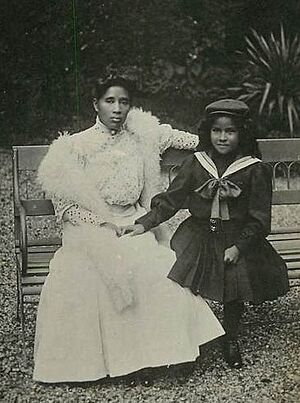
Ranavalona died without ever returning to Madagascar. Her requests to go home in 1910 and 1912 were denied. She died suddenly at her house in Algeria on 23 May 1917. She was 55 years old. Ranavalona was buried at the Saint-Eugene cemetery in Algiers on 25 May. Many friends, admirers, and important people from Algiers attended her funeral.
The French colonial government in Madagascar did not show the same respect. In 1925, they were told that payments for Ranavalona's tomb were overdue. They were asked to pay for its upkeep, but they refused twice. The tomb was never fixed. In November 1938, Ranavalona's body was moved. It was re-buried in the tomb of Queen Rasoherina at the Rova of Antananarivo in Madagascar.
A fire in 1995 badly damaged the royal tombs. Most of the buildings at the site were destroyed. Ranavalona III's remains, wrapped in lamba cloth, were the only ones saved. They have since been re-buried in the royal tombs at Ambohimanga.
After Ranavalona died, her aunt Ramasindrazana moved to France. The queen's adopted daughter, Marie-Louise, had left Ranavalona's house earlier to study. She later married a French engineer in 1921. Marie-Louise received a small pension from the French government. She became a nurse and was given the Legion of Honor for her work during World War II. Marie-Louise later divorced and lived a lively social life. She died in 1948 without children and was buried in France.
In 2020, a collection of Ranavalona's fashion, photos, and letters was bought by Madagascar's government. These items were found in an attic in England. They belonged to Clara Herbert, who worked for the Malagasy royal family from the 1890s to the 1920s. The objects will be displayed in the restored Queen's palace in Madagascar.
Images for kids
See also
 In Spanish: Ranavalona III para niños
In Spanish: Ranavalona III para niños


